 |
- a. THE FLYING TIME FROM THE EARTH TO THE MOON can be expressed
as a three-week, nonstop ride in a jet airplane, traveling at 500
miles per hour. It would take approximately one school day to
fly across the continental United States at the same speed.
- b. TRAVELING TO THE MOON BY CAR at 55 miles per hour for 12 hours
a day would require one year’s worth of time to complete the
trip. Of course, one would have to return which would require
an identical amount of time. A student could miss two full years
of school on a round trip to the moon. Any volunteers...?
- c. STUDENTS SHOULD REALIZE THAT THESE TRIPS ARE IMAGINARY: The
fact that the trips are imaginary should be stressed after
telling the story or giving the example. A good follow-up to
this concept is to ask your pupils why the trip would be
impossible. Sometimes their answers can be quite perceptive.
2. THE MOON IS SMALLER ACROSS (IN DIAMETER) THAN THE UNITED STATES IS WIDE.
If the Earth were hollow, about 50 moons would fit inside.
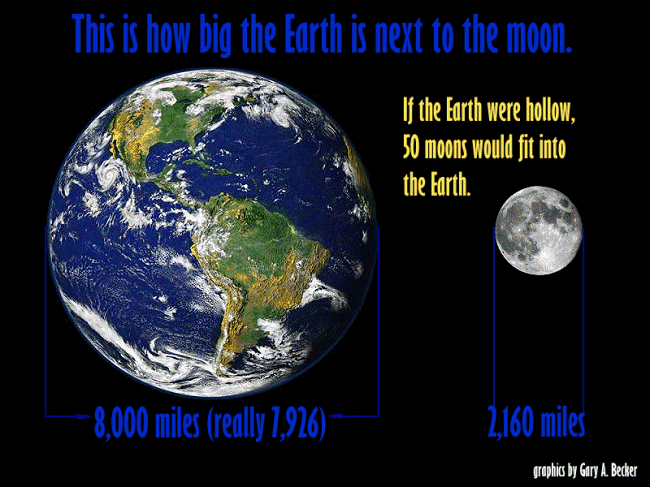 |
- a. THE MOON IS SMALLER THAN THE EARTH:
FIFTY MOONS WOULD FILL THE EARTH. This segment of the
lesson can be prefaced with a short discussion about how the
Ukrainians decorate Easter eggs. They perforate the egg at
either end and blow out the "guts." This sets the children up
for a joke which goes something like this: "But, of course,
sometimes the egg cracks and the yolk's on you." This
digression leads to the statement that if the Earth were
hollowed out like an egg, leaving the shell, which we call
the crust, one could drop 50 moons into the Earth before it
would be completely filled. The number 50 is really an
introduction to the next concept which is to be discussed.
- b. SIZE OF THE UNITED STATES: Sketch a map of the United States on
the blackboard and have the children identify the drawing. Locate
Allentown, PA and a West Coast city, such as San Francisco. Many
children can identify with the song, "I Left My Heart in San
Francisco." Next, elicit from the children the correct distance
between these two cities which is about 3000 miles. If the
responses are way off-beat, interject by saying something like,
"Wait a moment. Let me give you a hint. The distance between
Allentown, PA and San Francisco is between 50 and 7000 miles."
Upon receipt of the next realistic response, draw a line from
Allentown towards San Francisco, approximating that distance
and continue adding (or subtracting) from the line until the
correct distance of 3000 miles is obtained. The appropriate
answer usually follows in short order.
- c. COMPARE THE SIZE OF THE MOON, THE SIZE OF THE UNITED STATES,
AND THE SIZE OF THE EARTH: Pose the question, "Is the moon bigger
than the Earth?" followed by "Is the moon bigger or smaller than
the United States?" Take a census of student opinions by asking
for a show of hands and noting the responses on the blackboard.
After the results are tabulated, the correct answer is
acknowledged. Many elementary students assume that the Earth is
larger than the moon. After all, the moon appears small in the
sky in comparison to the huge Earth beneath their feet. But
these same students will recite with the same forcefulness that
the moon is much larger than the United States. Draw
an appropriately sized 2000 mile diameter circle within the
framework of the original US map. The audience response is
usually enthusiastic. You do not want your pupils to be left
with the impression that the moon is insignificant with respect
to an individual. An appropriate retort might go something
like, "Even though the moon is smaller than the Earth and
smaller than our country, if you were an astronaut walking on
the moon, would it look big or small?" The student response is
always "big." From the size of the circle drawn within the
framework of the United States, the students will recognize the
correct diameter of the moon (2000 miles). A scale model of
the sun (82 inches in diameter), the Earth (0.8 inch), and the
moon (0.2 inch) will also help to bring the size differences of
these three objects into sharper focus.
3. THE EARTH IS MUCH HEAVIER
MORE MASSIVE) THAN THE MOON:
If the Earth were placed on one side of a balance scale, 81½ moons would
be needed on the other side to equal the Earth's weight.
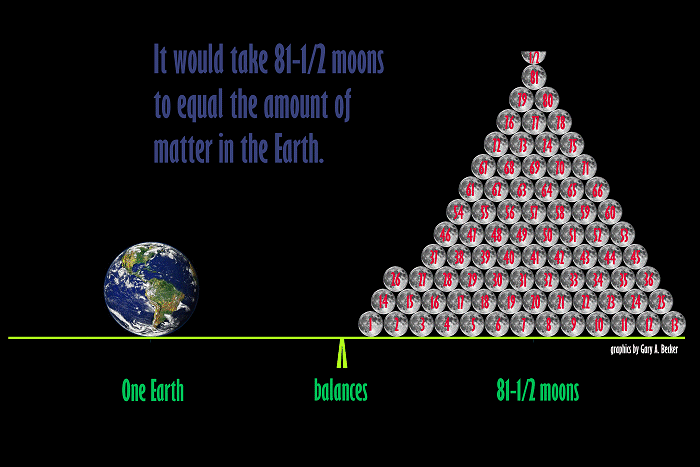 |
A SEESAW BALANCED WITH MOONS: This concept can be made more
dramatic by actually sketching the 81½ moons stacked opposite the
Earth on a seesaw (balance) scale. Since the children are now aware
of the small size of the moon when compared to Earth, virtually
everyone will concede that the Earth must be heavier than the moon.
But how much heavier...? Many moons would be needed on one side of
the scale to balance the Earth on the other side. Survey the class,
using the answers of five or six students to establish an opinion.
A typical numerical range might be 8, 20, 50, 75, 120, and 500.
A response of 50 is almost assured. This limits some of the more
absurd statements which elementary children are prone to give under
such circumstances. The number 50 also acts like a barometer
indicating the successfulness of the approach. It certainly is
reasonable to assume that if it requires 50 moons to equal the
volume of the Earth, then the Earth should weigh 50 times more
than the moon--a nice piece of deductive reasoning for an elementary
pupil. Next, sketch a seesaw on the blackboard and proceed to tell
the class several childhood experiences related to seesaws. Bill
Cosby's Fat Albert routine is a good one to get the kids going.
"What if Fat Albert (Hey, Hey, Hey) sat on the one end of the
seesaw? Why it might take everyone in his class, piled up on the
other side of the seesaw, just to lift him off the ground! You'd be
calling all of your friends and they'd be jumping on the seesaw
screaming and yelling, and Fat Albert would be sitting there
across from you with that funny little smile on his face saying,
"Hey, Hey, Hey..." Well, we're going to pretend that the Earth
is Fat Albert, and I want to see how many moons it's going to
take to lift Fat Albert-- I mean the Earth-- off the ground."
Sketch a large Earth on one side of the seesaw and begin to draw
and count moons on the opposite side of the seesaw, using voice
inflections to make it appear as if you have come to the end of
the exercise at each one of the numbers that the students have
suggested. Ask the opinion of the class concerning each number.
The first is usually mixed, while the rest up to 49 are usually no.
Everyone always feels that 50 is the magic number, with many
of students showing disbelief as the counting continues upward.
When completed, the children are presented with an easy-to-understand
visual concept of the size and weight (mass) of the moon as compared
to the Earth.
4. THE MOON HAS GRAVITY, but it is much
less than the amount of gravity which the Earth possesses. Generally speaking, larger planets
and moons have more gravity than smaller planets and moons.
- a. GRAVITY IS NOT UNIQUE TO THE EARTH: An opinion poll generally
establishes the fact that the majority of elementary students
feel that the moon does not possess gravity. Note the number of
gravity believers and gravity nonbelievers on the blackboard.
Even if the nonbelievers win, side with the majority decision,
specifically telling the children who believe in the gravity
theory that they may not participate in the next question.
Then address yourself to the nongravity believers and ask them
to explain how the astronauts could possibly have walked on the
moon if the moon did not possess any gravity. Here are a
sampling of their imaginative answers:
- 1. The astronauts had lead in their boots.
- 2. Their spacesuits held them down.
- 3. They wore suction cups on the underside of their
boots.
- 4. The astronauts took rope and tied it to their
spaceship.
- 5. The astronauts' boots were equipped with sharp
spikes.
- 6. They brought gravity (in cans) with them.
- b. PROVING THAT THE MOON HAS GRAVITY: As these statements
are being made, contradict their ideas by showing pictures, if
possible, of various Apollo missions and pointing out the
fallacies. "Look at those footprints. Do you see any spike
marks or suction cup marks where the astronauts walked? Are
the astronauts carrying any rope? Do you see any bottles of
gravity lying about? Yes, the astronauts’ boots were weighted,
but would this weigh anything if there was no gravity?" On and
on it goes until finally someone from the nonbelieving side
says in a sheepish voice, "I think the moon has a little
gravity. Your response could be one of disbelief--"WHAT, ARE
YOU CRAZY?!! We have a person who is changing sides. Are you
sure you want to do it?" Erase a mark on the "no" side of the
board and change it to the "yes" column. Several more hands
will probably go up with changes of opinion. The concept that
the moon has gravity has been born. Have the class applaud
the several pupils who were originally aware of the gravity
concept, as well as the first individual who had the courage to
change his or her mind. Stress that because the moon is smaller
and lighter (less massive) than Earth, it does not possess as
much gravity as our planet, but that a little bit of gravity
goes a long, long way. All stars, planets, moons, asteroids,
and comets, etc. have gravity. "And what about that cow--did it really
jump over the moon?"
- c. MORE ON GRAVITY: The gravity concept concerning the
moon is frequently so misunderstood that it can be given added
emphasis with several participatory demonstrations.
- 1) HOW FAST DO OBJECTS FALL ON THE MOON? An object,
such as an eraser, dropped from a height of four feet will
require an interval of one-half second before it strikes
the floor. The moon's gravitational force is approximately
one-sixth that of Earth's attraction, so an eraser dropped
from the same height on the moon would require three
seconds of time before striking the lunar surface. This
can be easily demonstrated for Earth by dropping an
eraser (penny, pencil, ball) from four feet and then
repeating the procedure for the moon. The major exception
is that for the moon, the teacher or student must hold onto
the object as it "falls" towards the floor. To estimate
three seconds, count briskly, one thousand-one, one
thousand-two, one thousand-three. Do not use items which
may be affected by air resistance, such as a sheet of
paper, a tissue, or a balloon. These would work admirably
if the Earth did not possess an atmosphere, but because
it does, the descent of these objects is considerably
slowed by the molecules of air which must be pushed away
from the path of the falling article.
- 2) LUNAR LYMPICS: Here is a superb way of combining
astronomy, mathematics, and athletic prowess all into
one of several fast-paced lessons with everybody looking
like a winner. Sponsor an athletic competition with
events comprised of throwing or kicking balls and
calculate their lunar equivalents if the games were held
on the moon. Measure the straight-line ground distance
from where the event initiated (the ball was thrown) to
where it landed. Multiply this number by six for the
moon. If some estimate of height can be made, this
number can generally be multiplied by six also. Other
interesting competitions are the broad jump or the
running broad jump, as well as a contest to see how high
a student can jump from a standing position. In the
latter case, measurements should be made from the tops
of the students' heads, since they have a tendency to
lift their feet in the jumping process. Beware of
Frisbee and high jump contests, for they will not give
accurate results when translated into the lunar
environment. Air currents will affect the path of a
Frisbee, and, of course, the moon has no air. In the high jump,
the individual may elevate
himself or herself five or six feet before clearing the
bar. This does not accurately reflect the true height
that the person has been lifted off the ground. It is
the elevation of the center of mass, the balance point
of the various parts of the body, that is of concern.
The center of mass for the human body corresponds to
the pelvic area which is already elevated about two and
a half to three and a half feet above the ground for an
adult. When a successful jump is made, the athlete
clears the bar in a horizontal position, lifting his
or her center of mass from the three foot level to just
slightly above the height of the bar. If the bar was
at the six foot level, and an athlete had his or her
center of mass at three feet, the lunar equivalent would
place the bar at 21 feet, not at 36 feet, as might be
expected from the other examples--(3 x 6) + 3 = 21.
Mrs. Ruth Erie of Ritter Elementary provided the
inspiration behind this idea.
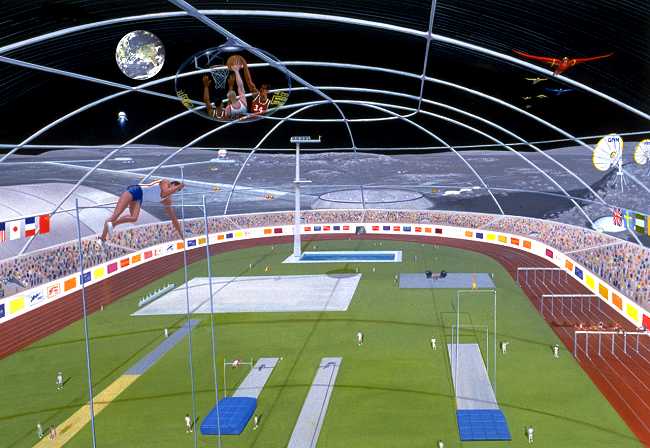 |
| First Lunar Olympics: With only 1/6th the gravity of Earth, you would have to divide your weight by 6 to see what you would weigh on the moon. On the moon most third graders would probably weigh between 8 and 15 pounds. Could you imagine what it would be like to play in the first lunar olympics? Drawing by NASA-public domain image… |
- 3)YOUR WEIGHT ON THE MOON: This is a good
exercise especially for our weight-conscious society,
because again, everyone wins. Simply divide the
students' weights by six to obtain an excellent
approximation of their lunar equivalents. Even the
Dimensions Magazine heavyweight would tip
the scales at a mere 267 pounds. How
much did she weigh on the Earth? It should be brought to
the attention of the class that even though everyone
would weigh less on the moon, physical appearances
would remain unchanged.
5. THE MOON SHINES BY REFLECTING SUNLIGHT INTO OUR EYES.
Planets shine by the same process. Stars, on the other hand, make their own
heat and light by changing (fusing) hydrogen gas into helium, deep within their
interiors.
DEMONSTRATING REFLECTION: In a darkened room, illuminate a child
with a flashlight to demonstrate how we can observe objects by reflected
light. Most children will be able to understand the concept of reflection
through the analogy of a mirror. Mime a shaving routine, the combing of
your hair, the application of makeup or the tying of a tie with a
comment such as, "Oh, do I look great today!" The children will quickly
"reflect" that you are looking at yourself in a mirror and, with ease, a
definition for reflection can be quickly ascertained. The demonstration of
reflection with a flashlight can be easily enhanced if the teacher, with
his or her hand, traces the beam of light to the child's face and gently
ricochets it to the eye of another class member. The moon, of course,
is not a mirror, but the principle of light reflecting from its surface
remains the same.
6. THE MOON HAS NO ATMOSPHERE (AIR):
The moon does not possess a sufficient amount of gravity to hold down an atmosphere.
- a. ALL STUFFED UP--BREATHING ON THE MOON: To emphasize the
difficulty of living on a world without air, have your pupils close
their mouths, pinch their noses shut, and try to breathe.
- b. A BREATH HOLDING CONTEST: The teacher requests a male
and female volunteer for the next part of the lesson without
specifying the exact nature of the request. When the "victims"
are chosen, try to weave them into a story which is told
something like this. "John and Marie were chosen by NASA, the
space people, to be the first kids from Earth to fly to the
moon with their parents. They boarded their rocket at Cape
Canaveral in Florida last Sunday and spent the last three days
in space cruising to the moon. You can imagine how excited and
eager they were to play on Earth's nearest neighbor, because
they had studied in school that the moon had less gravity than
Earth. "Come on, John! Let's go out and see what the moon is
really like," Marie shouted. They both ran over to the air
lock chamber. Marie took her new electric bike with her and
John grabbed his ball and bat. The blue air lock door swiftly
closed behind them, and Marie excitedly ran over to the exit
door that would let her out onto the moon's surface. John
pressed the red button and almost instantly the big gray
aluminum exit door began to slide upward. As sunlight came
streaming through the opening, a look of horror flashed across
John's face. "The spacesuits, Marie! We forgot to put on
our spacesuits!" Because of the lack of air, Marie could
hardly hear the last few words that John was shouting. Quickly
they tried to take one last deep breath, but it was difficult
because most of the air had already escaped from the room.
John pushed with all of his might on the switch that would
close the door behind him, but he knew that it would be at
least two minutes before the door could be reactivated and
they could seal off the room. Would they survive their ordeal
or would they be the first dead space kids on the moon?" Of course they
would not live! You haven't even told them that the sudden
decompression would render our hero and heroine unconscious,
and certainly sweep them out of the air lock and onto the moon's
rocky surface. You must remember those horrible decompression
scenes in all of the Airport movies many years ago. There was
always someone being sucked screaming out a window at 30,000
feet. Such trivial matters, however, can be left for eighth
grade discussions. Marie and John now hold their breath for
as long as they possibly can to see if they will survive.
Most of the students successfully hold their breath for about
30 seconds, although 45 seconds is not that uncommon. One
student maintained his composure for just under two minutes.
The teacher was in the midst of dialing 911 when he exhaled.
The concept that the moon has no atmosphere is aptly portrayed
through this "life-threatening" participatory skit. Some other
related suggestions follow:
- c. DOES IT EVER GET WINDY ON THE MOON? Because wind is
really air in motion, and because the moon has no air, it could
never get windy on the moon. The instructor can inflate a
balloon, then deflate the balloon in the faces of several
students. As the air rushes out of the balloon, the students
will be able to feel a gentle breeze against their faces.
- d. WHY DOES IT APPEAR THAT THE AMERICAN FLAG IS
BLOWING IN THE WIND? The flags are braced by a
horizontal support at the top of their poles to give them the
appearance that they are rippling in the wind.
- e. IF AN ASTRONAUT, WHILE ON THE MOON, FILLED A BALLOON
WITH HELIUM GAS, WOULD THE BALLOON RISE, FALL, OR STAY EXACTLY
WHERE THE ASTRONAUT LEFT IT? Lead into this question by filling
a balloon with helium from an unmarked can. Explain to the
class that you have great difficulty in inflating balloons, and
that the air can is of great help. When inflated and tied,
hold the balloon at arm's length and leave it go. The reaction
of the class to the rising balloon is worth the effort of
tracking down a supplier. Next offer the balloon as a prize
to the first individual who can correctly give the proper
explanation to the question. The balloon containing helium gas
will rise on Earth, only because its combined density
(mass/volume of the balloon and helium gas) is less than the
density of a comparable volume of air. You could substitute
weight for density in this explanation. Since there is no air
on the moon, the helium-filled balloon will simply fall to the
moon's surface. An acceptable response from a student might
proceed like this: "The balloon rises on Earth because it is
lighter than the air. It will fall on the moon because there
is no air on the moon, so the balloon cannot be lighter than
the air."
7. A SCRAPBOOK OF APOLLO 11 PICTURES (for kids): First humans to walk on the moon.
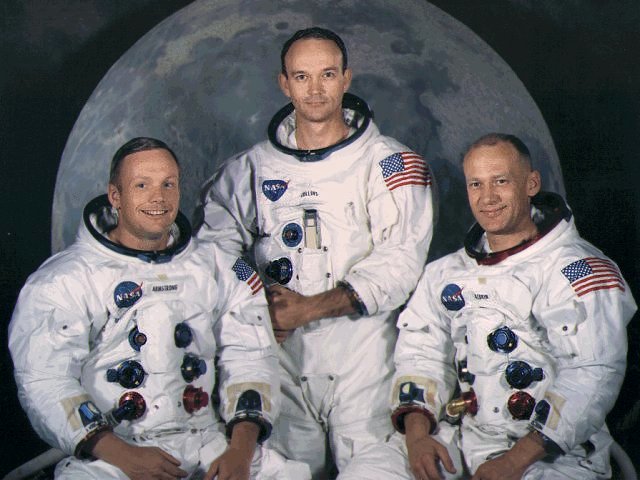 |
| Apollo 11 Crew: This is the most famous picture taken by NASA of the three-member crew that flew in Apollo 11, the first mission where people walked on the moon. Everyone knows that Neil A. Armstrong was the first astronaut to walk on the moon, but do you know his location in the picture? The astronaut sitting on the right is Buzz Aldrin, the second person to walk on the moon. The standing astronaut is Michael Collins. He remained in the Command Module while Buzz and Neil walked. Yes, Neil is seated on the left with the biggest smile. |
 |
| Command Module: You are looking at the Command Module near the top of the Saturn V rocket that took the astronauts to the moon. Three Apollo astronauts lived in the Command Module while traveling to and from the moon. Do you see the man leaning against the white pipe over to the left of the picture? The Saturn V Launch Vehicle was 363 feet tall and you are seeing it near the very top. NASA photo 69-HC-718... |
 |
| Launch of Apollo 11 On July 16, 1969, Neil Armstrong, Buzz Aldrin, and Michael Collins blasted off for the moon. The Saturn V rocket and Spacecraft section in the picture above was 363 feet high. NASA Photo-KSC-69PC-442, labeling, G. A. Becker... |
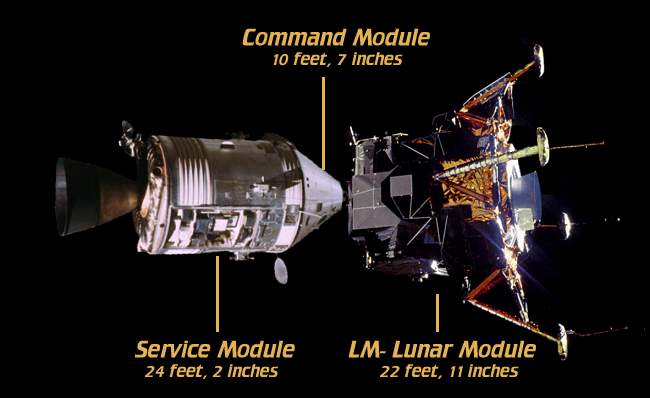 |
| Over Five Stories of Equipment Went to the Moon: After the third stage of the Saturn V rocket fired towards the moon, the Command and Service modules separated from the Lunar Module storage area (also known as the Instrument Unit). The Command Module with the Service Module attached had to come around and attach itself to the Lunar Module and pull it from the storage area. This picture was made from two images, the first picture showing the Service and Command modules, and the second showing the Lunar Module. Adam R. Jones scaled the two images to their correct proportions. Modified NASA photographs... |
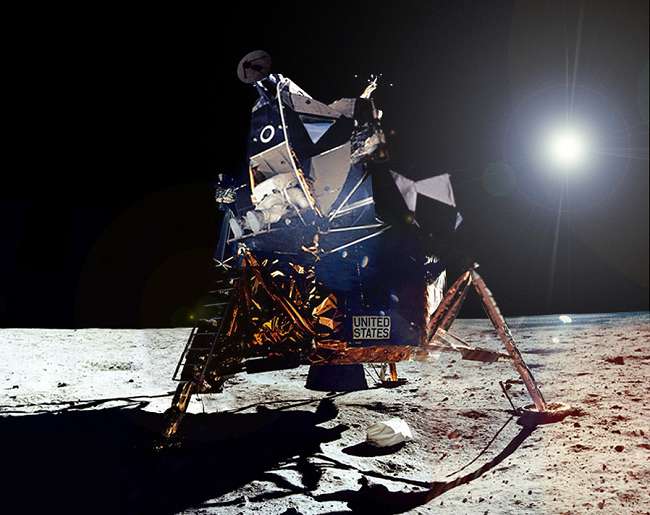 |
| Aldrin on the Porch: This photo was put together from four separate photographs that Neil Armstrong took while on the moon. It shows the Lunar Module “Eagle” and Buzz Aldrin backing out onto the porch ready to begin coming down the ladder. There was so little room in the Lunar Module that Neil Armstrong had to exit first to leave enough room for Buzz to back out. Lunar Module "Eagle" composite by Ed Hengeveld, NASA photo AS11-40-5864... |
 |
| First Steps: The fuzzy black and white photo is from an automatic video camera that recorded Neil Armstrong coming down the ladder and taking his first step on the moon. A few minutes later, Neil Armstrong photographed Buzz as he became the second human to walk on the moon’s surface. Modified NASA photos... |
 |
| Neil Armstrong's First Photograph: This is the very first photograph that Neil Armstrong took after stepping off the Lunar Module footpad and becoming the first person to walk on the moon. NASA photo AS11-40-5850... |
 |
| Buzz Aldrin at Work: This picture shows Buzz Aldrin removing equipment from the storage area of the Lunar Module. Most people don't realize how big the Lunar Module (LM) really was. It had two parts, the Descent Stage, which was used to brake and land the LM on the moon. Above it was the Ascent Stage that would carry the astronauts back to the Command Module, and eventually, home to Earth. The astronauts also lived in the Ascent Stage after the LM landed on the moon. The Descent Stage of the LM remained on the moon when the astronauts returned to the Command Module in orbit around the moon. The Lunar Module was nearly 23 feet in height. NASA photo AS11-40-5927... |
 |
| Neil Armstrong After His Walk: That's one happy camper of a man. Neil Armstrong relaxes in the cramped Lunar Module after finishing his first walk on the moon. NASA photo as11-37-5528HR... |
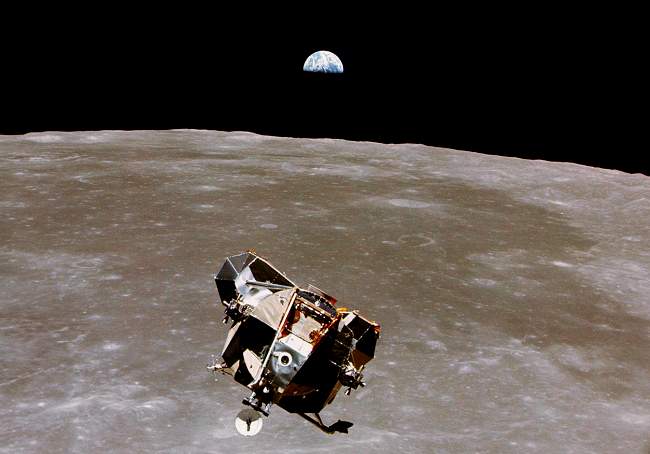 |
| Ascent Stage Returns: If you see a picture of only the Ascent Stage of the Lunar Module (LM), you know that the astronauts are returning from their mission on the moon and getting ready to dock with the Command Module. NASA photo AS11-44-6642... |
|
8. ASTRONAUTS SURVIVE ON THE MOON BY WEARING SPACESUITS
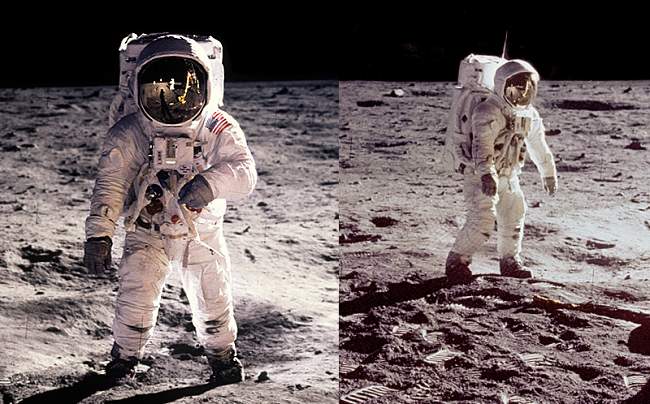 |
| Spacesuits are, in effect, small, airtight, flexible rooms that fit around people. The Apollo spacesuits duplicated Earth-like conditions within their interiors, while at the same time, they protected the astronauts from the harsh lunar environment. These pictures are of Buzz Aldrin, the second human to walk on the moon. NASA photographs... |
|
- a. A PORTABLE LIFE SUPPORT SYSTEM (PLSS) KEPT THE
ASTRONAUTS ALIVE WHILE THEY WERE ON THE MOON: A constant
supply of oxygen was maintained by the backpack (PLSS) which
the astronauts wore. Pure oxygen was supplied to the
astronauts at a pressure of 3.75 pounds per square inch. This
could be maintained for a period of seven hours of
extravehicular activity dependent upon the astronaut's
metabolic rate. The tank in the PLSS unit was rechargeable.
An emergency purge unit, directly above the PLSS, could supply
an additional 30 minutes of oxygen if difficulties arose with
the main tank. The emergency system was never used. The PLSS
supplied oxygen to the Pressure Garment Assembly, an inner
spacesuit worn under the Integrated Thermal Micrometeoroid
Garment. See section "d" below.
- b. SPACESUIT TEMPERATURE CONTROL: Internal temperature
control was maintained by a water-cooling system located in
the PLSS and controlled by the astronauts. Cool water was
circulated through a network of Tygon tubing which was woven
into the outer layer of the astronauts' one-piece, Liquid
Cooling Garment. Since the spacesuits were highly insulated,
the cooling system was designed primarily to alleviate the heat
generated by the astronauts' own metabolic functions, rather
than the heat produced by sunlight striking the suit's exterior.
The white color of the suits reflected most of the sunlight
anyway.
- c. THE SPACESUITS PROTECTED THE ASTRONAUTS AGAINST THE
SUN'S HARMFUL ENERGY: The spacesuits, as well as the
multilayered special coatings of the Lunar Extravehicular Visor
Assembly mounted on the helmet, protected the astronauts from
the harmful tanning (ultraviolet) and heat (infrared) energy
emitted by the sun. On the Earth, most of this harmful energy
is absorbed by the atmosphere.
- d. THE INTEGRATED THERMAL MICROMETEOROID GARMENT was
the outer spacesuit seen in all of the extravehicular
activities which occurred on the moon. It insulated the
astronauts from harmful solar radiation and protected the Inner
Pressure Garment Assembly from penetration by very small, high
velocity space debris called micrometeorites.
- e. OTHER INTERESTING SPACESUIT FACTS: The spacesuits
weighed 183 pounds on Earth. Even though the moon's diminished
surface gravity reduced this to about 30 pounds, the suits did
not allow much room for mobility. These factors made hopping a
more preferable mode of locomotion over simple walking. The
awkwardness of the suits necessitated the creation of a host
of special tools which allowed the astronauts to collect
samples and work from a standing position rather than from a
bending or a kneeling posture.
9. THE TEMPERATURES ON THE MOON'S SURFACE CAN BE BOTH HOT AND
COLD NEAR THE SAME LOCATION. An astronaut standing in the open sunlight
without a spacesuit would experience a temperature of about +250
degrees F. on his body, while in the shadow of a large boulder, or at
night, the temperature would drop to around -250 degrees F.
- a. THE RANGE OF TEMPERATURES IS DUE TO A LACK OF AN
ATMOSPHERE: The great range in temperature from sunlight to
shadow, or at night, results from the lack of an atmosphere which
would allow for the transfer of heat into shadow zones via wind
currents or the kinetic action of molecules. On Earth, the
sun heats the air directly or heats the ground, which in turn,
heats the air. Local and global wind patterns, which are
created by this thermal imbalance, help to mix the atmosphere
and moderate temperatures. Also, molecules of air in sunlight
are traveling faster than the molecules of air in the cooler,
shadowed zones. The resulting collisions between faster moving
molecules, representing hotter air, and the slower moving
molecules, represented by the cooler air of the shadowed
zones, have the net effect of transferring energy into the
shadowed areas, thus making them warmer. This does not happen
on the moon.
- b. DOES THE SPACE ABOVE THE MOON'S SURFACE HAVE ANY
TEMPERATURE? The answer must be no, since the moon does not have
an atmosphere that can be warmed by sunlight or ground heat.
The temperatures measured on the moon are simply the ground
temperatures.
10. TO AN ASTRONAUT, THE MOON'S SURFACE WOULD APPEAR VERY DARK
because it is composed exclusively of igneous rock, rock which is
generally dark in color. All igneous rock begins in a molten
state and is related to some type of volcanic activity. Depending upon
the lunar location, the shades of gray would vary from the way clouds
look on a dark rainy day to the blackness of a freshly macadamized
roadway.
- a. THE LUNAR SKY WOULD APPEAR BLACK even very close
to the sun because the moon has no atmosphere to scatter light.
- b. STARS WOULD NOT BE VISIBLE because of the nearly 20
coatings deposited on the Lunar Extravehicular Visor Assembly
(helmet) to protect the astronauts' eyes from glare and the
sun's harmful energy. Without these protective coatings the
stars would have been readily visible on the daylight side of
the moon as the astronauts made their way over its cratered
surface.
- c. THE MOON'S SURFACE WOULD APPEAR TO BE DUSTY AND ROCKY.
Small craters would be visible everywhere as well as possibly
rounded mountains or hills in the distance.
| The dusty and rocky lunar landscape extends forever in this Apollo 17 photograph. In the distance is home and transportation back to Earth, the Lunar Module. NASA photo as17-139-21204... |
|



| | | | | | | | | | | | | | | | ![]()
![]()















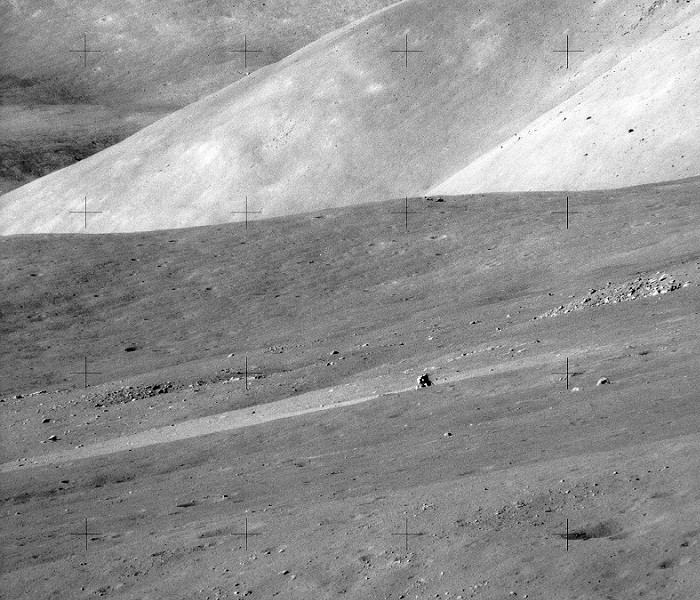
![]()